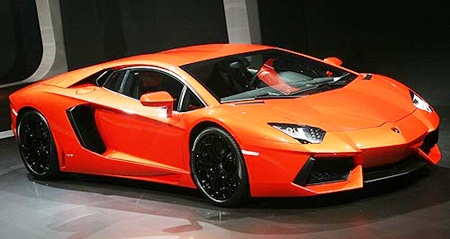Lamborghini released the successor to the Murcielago at the Geneva Motor Show, called the Aventador LP700-4. Similar in looks, it has, however, much different technology with a new V12 engine, a carbon-fiber monocoque chassis and pushrod suspension.
The monocoque tub chassis weighs only 147.5 kg and offers very high torsional rigidity. It has aluminium sub-frames at each end onto which the suspension, engine and transmission are mounted.
The name comes from a particularly brave Spanish fighting bull and the LP 700-4 refers to the engine output in horsepower and the fact that it drives all four wheels.
 Lamborghini Aventador
Lamborghini Aventador
The new engine is a short-stroke V12 rated at 515 kW (at 8250rpm) which is more powerful than the Lambo LP 640 and LP 670, and has a marginally better torque output (690 Nm versus 660 Nm).
Being a lighter car than the predecessor (90 kg), the factory figures for the Aventador claim zero to 100 km/h in 2.9 seconds and a top speed of 350 km/h, making it one of the quickest and fastest production cars ever built.
The claimed consumption figures are 17.2 L/100 km EC combined and CO2 output (398 g/km) is down by 20 percent – as if anyone cared when you are slapping down something I estimate will cost 80 million baht in this country. In fact, I have never met anyone who either knows, or cares, about the CO2 output of their car.
Transmission is through a seven speed auto transmission, which it is claimed is the fastest robotised gearbox in the world, with shift times of 50 milliseconds (40 percent faster than the Gallardo). However, this is not a dual clutch transmission.
The driver can select Strada (road), which offers a fully automatic shift, the more focused Sport and the extreme Corsa (race), which includes launch control.
The Aventador has the scissor doors (as Countach, Diablo and Murcielago), and an optional transparent cover to show the mid-mounted engine, an aggressive rear diffuser and an electronically-deployed rear wing, which sits flush with the bodywork at rest, rises to 11 degrees at mid-range speeds for greater downforce and flattens out to only four degrees at high speeds to reach maximum velocity while assisting directional stability.
Other Aventador features include electronically controlled air intakes for the engine, carbon-ceramic composite disc brakes (400mm in diameter at the front with six-piston calipers and 380mm with four-pot calipers at the rear), an electronic parking brake, 19 inch rims on 255/35 section tyres at the front and 20-inch rims with 335/30 rubber at the rear.




